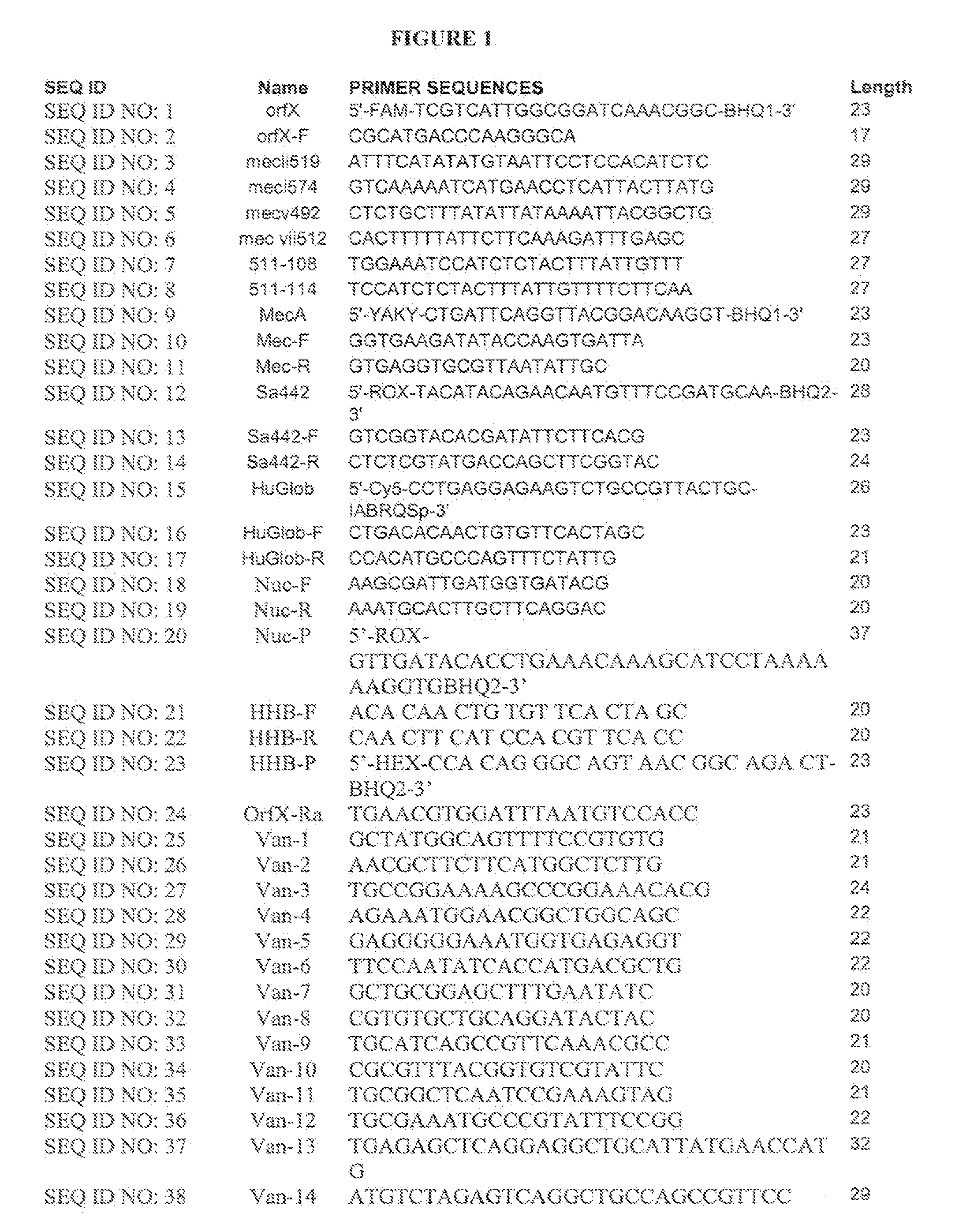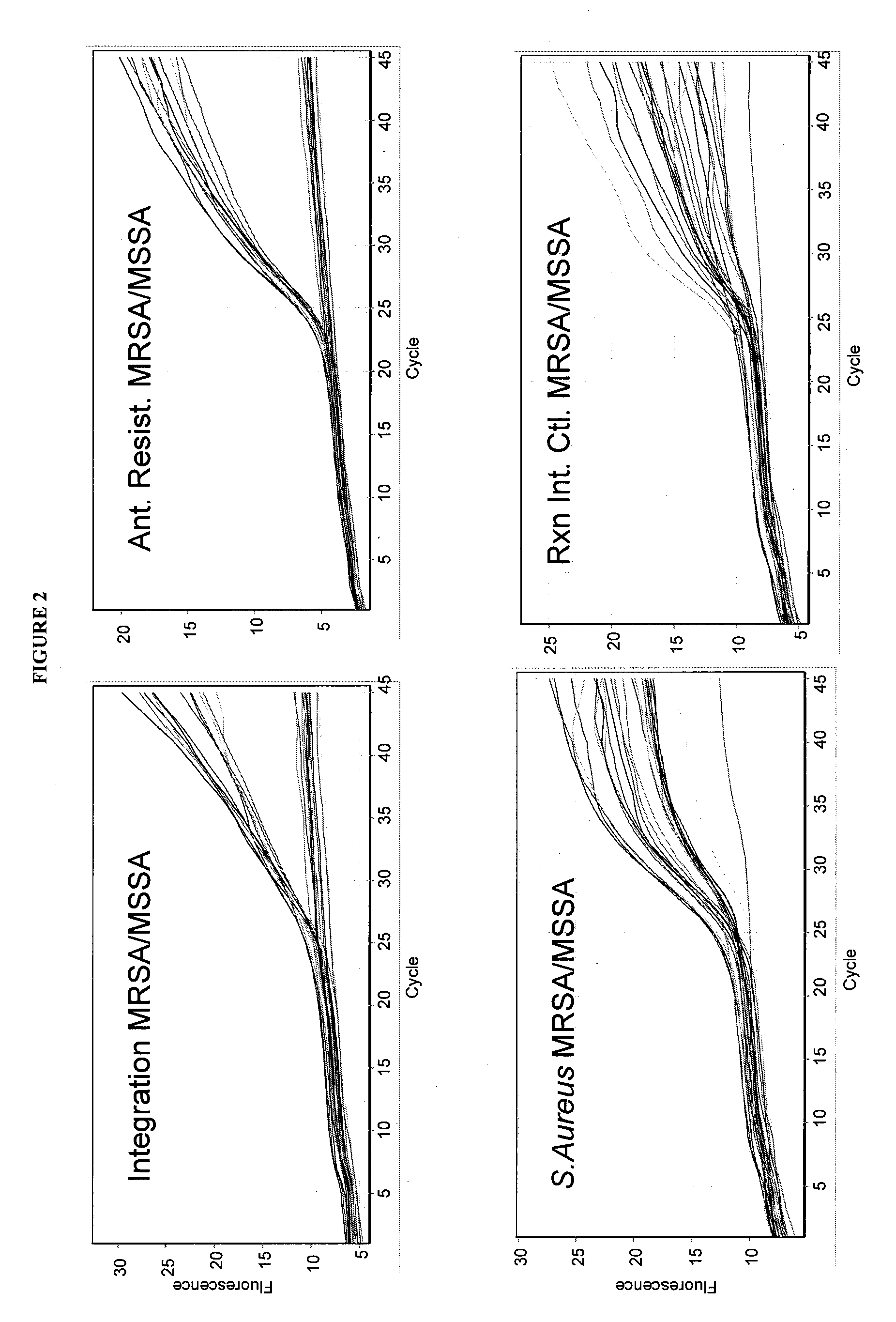Methods, compositions and kits for detection and analysis of antibiotic-resistant bacteria
a technology of antibiotic-resistant bacteria and detection methods, applied in the field of detection of antibiotic-resistant bacteria in a sample, can solve the problems of ineffective treatment of limited treatment options for inability to effectively treat infections caused by such strains, etc., to achieve fewer false positives and false negatives, improve detection accuracy, and improve the effect of detection accuracy
- Summary
- Abstract
- Description
- Claims
- Application Information
AI Technical Summary
Benefits of technology
Problems solved by technology
Method used
Image
Examples
example 1
Single and Double Locus Assays Using Pure Culture Samples
[0157]A single locus qRT-PCR assay for detecting MRSA was performed using methods based on Huletsky et al (US 20050019893 and US20060252078). This assay uses multiple primers and a dual labeled probe for hybridization of the right extremity junction of SCCmec:orfX. Detection of human P globin was added as an internal control. A dual labeled probe complementary to the S. aureus orfX region (SEQ ID NO: 1) was used. A forward primer complementary to the S. aureus orfX region (SEQ ID NO: 2) and six reverse primers complementary to MREJ sequences in the Sccmec element. “MREJ” refers to “poly-Morphic Right Extremity Junction”. In Huletsky et al., US Patent Publication No. 20050019893, MREJ is a sequence toward the right end of the SCC mec cassette that is prone to mutation—many different MRSA strains will show variations in this region of their genome. Types i, ii, iii, iv and v of the SCCmec gene (SEQ ID NO: 3-SEQ ID NO: 8) were us...
example 2
Demonstration of the Limited Accuracy of Single and Double Locus Assays in Differentiating MRSA from MSSA, MS-CoNS, and MR-CoNS Using Clinical Patient Samples
[0168]qRT-PCR reactions were performed using the Single Locus Assay and Double Locus Assay as described for Example 1 herein above with 460 samples of patient DNA derived from cultured swabs which contain mixed populations. The reactions were run as described herein above utilizing a standard qRT-PCR reaction mixture (Absolute™ QPCR Mix from ABgene) and standard qRT-PCR protocol described above, with amplification and detection run using a RotorGene 3000 System Real Time PCR instrument from Corbett Life Science.
[0169]All runs contained 2 NTC samples (No Template Control), and known MRSA, MSSA, and MR-CoNS controls. Clinical samples were plated and qRT-PCR was performed the next day on S. aureus suspected colonies only. All samples were analyzed for mixed population using the same bacteriological needle used to sample colonies f...
example 3
Demonstration of Superior Accuracy of Triple Locus and Cycle Threshold Assays
[0174]A triple locus high density multiplex qRT-PCR assay mixture was developed containing 17 oligonucleotides (SEQ ID NOs: 1-17). This multiplex assay mixture was tested on the same 460 patient DNA samples derived from swabs. The reactions were run using the standard qRT-PCR protocol described above with amplification and detection performed using a RotorGene 3000 System Real Time PCR instrument from Corbett Life Science.
[0175]The method of the present invention provides a two step process for analyzing results to substantively reduce false negative and false positive results. The first step is to separate results according to four classifications:
[0176]1. Positive on all 3 loci=MRSA
[0177]2. Negative on Sa442=Not MRSA
[0178]3. Positive on Sa442 and negative on mecA=Not MRSA
[0179]4. Positive on Sa442, positive on mecA and negative on SCC;orfX=Go to Step Two
[0180]Based on the first step analysis, 203 samples ...
PUM
| Property | Measurement | Unit |
|---|---|---|
| volumes | aaaaa | aaaaa |
| volumes | aaaaa | aaaaa |
| volumes | aaaaa | aaaaa |
Abstract
Description
Claims
Application Information
 Login to View More
Login to View More - R&D
- Intellectual Property
- Life Sciences
- Materials
- Tech Scout
- Unparalleled Data Quality
- Higher Quality Content
- 60% Fewer Hallucinations
Browse by: Latest US Patents, China's latest patents, Technical Efficacy Thesaurus, Application Domain, Technology Topic, Popular Technical Reports.
© 2025 PatSnap. All rights reserved.Legal|Privacy policy|Modern Slavery Act Transparency Statement|Sitemap|About US| Contact US: help@patsnap.com



